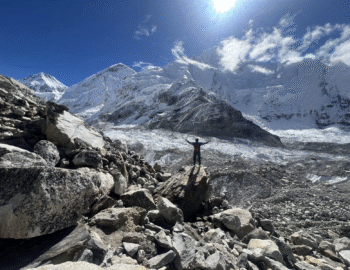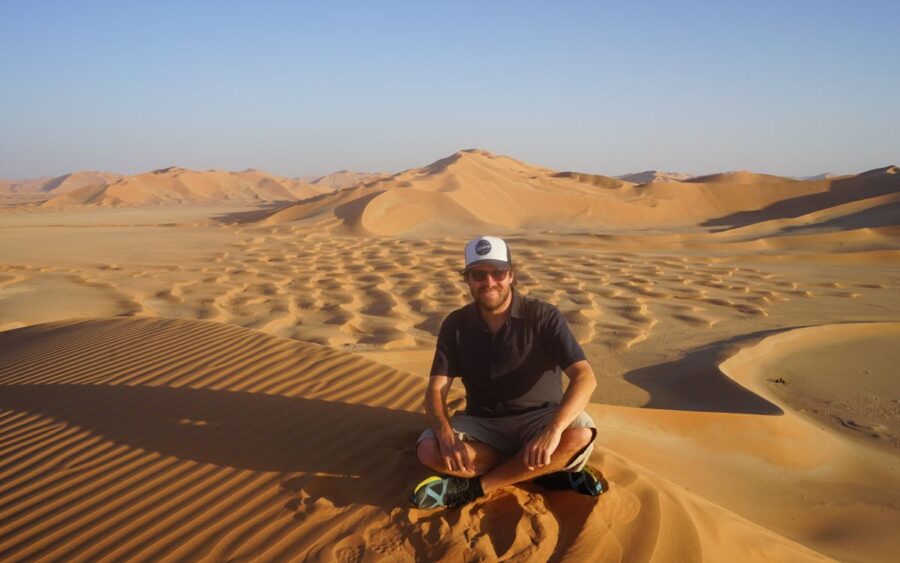When I first heard about the Manaslu Circuit, I’ll admit I had to pull up a map. While everyone talks about Annapurna and Everest, this trek around the world’s eighth-highest mountain seemed like Nepal’s best-kept secret. After completing it last autumn, I understand why experienced trekkers are increasingly choosing this route—and why it might just be the best trek I’ve ever done.
Manaslu Circuit
Let me take you through everything I learned about where the Manaslu Circuit is located and, more importantly, why you should seriously consider making it your next Himalayan adventure.
Finding Manaslu: Where Exactly Is This Trek?
Before I booked my trek, I spent hours studying maps, trying to understand where the Manaslu Circuit actually sits. Here’s what I discovered: the trek is located in north-central Nepal, about 130 kilometers northwest of Kathmandu in the Gorkha District. The route circumnavigates Mount Manaslu (8,163m), following the Budhi Gandaki River valley northward before crossing the dramatic Larke La Pass at 5,106 meters.
What really fascinated me was learning that the Manaslu region forms a natural border with Tibet to the north. This geographical position means the area is heavily influenced by Tibetan Buddhist culture—something I experienced firsthand in villages like Sama Gaun and Lho.
Getting there required a bone-rattling 7-8 hour jeep ride from Kathmandu to Soti Khola, where I started my trek. The drive itself was an adventure, winding through terraced hillsides and following rivers that would become my companions for the next two weeks.
My Journey Through the Manaslu Region
I completed the trek in 16 days, covering roughly 177 kilometers of incredibly diverse terrain. The first few days along the Budhi Gandaki were humid and subtropical—I was sweating through my shirt as I walked past banana trees and terraced rice paddies. Villages like Jagat and Philim introduced me to Gurung and Magar cultures, where locals still farm much as their ancestors did.
But around day five, everything changed. As I gained altitude, pine forests replaced banana trees, and prayer flags started appearing on every ridge. By the time I reached Sama Gaun at 3,530 meters, I felt like I’d crossed into a different world entirely. This stunning Tibetan Buddhist village, surrounded by snow-capped peaks, became my favorite stop on the entire circuit.
I spent two nights in Sama Gaun for acclimatization—one of the best decisions I made. The village monastery, the turquoise Birendra Lake just a short hike away, and the close-up views of the Manaslu Glacier made those rest days feel anything but restful.
Then came Larke La Pass. I won’t lie—crossing that 5,106-meter pass was the hardest day of trekking I’ve ever experienced. We started at 3am in bone-chilling cold, headlamps cutting through the darkness. But when the sun rose and illuminated Manaslu, Himlung Himal, and the Annapurna range stretched out before me, I understood why trekkers talk about this moment for years afterward.

Why I’d Choose Manaslu Over More Popular Treks
I’ve trekked to Everest Base Camp and completed sections of the Annapurna Circuit, so I have some basis for comparison. Here’s why the Manaslu Circuit won my heart:
The Crowds—Or Lack Thereof
On my busiest day on the trail, I passed maybe 20 other trekkers. Compare that to the Everest trail, where I sometimes felt like I was in a conga line. The Manaslu Circuit’s restricted-area permit status keeps numbers low, and I cherished the solitude. There were moments when I had entire mountain viewpoints completely to myself.
Authentic Cultural Encounters
Because tourism is still relatively limited, the villages I passed through felt genuine. In Sama Gaun, I shared butter tea with a family who’d never left their valley. The grandmother didn’t speak any English, but through my guide’s translation, she told me stories about life at 3,500 meters that I’ll never forget. These weren’t scripted tourist interactions—they were real.
The Scenery Rivals Any Trek in Nepal
I’d been told the views would be spectacular, but I wasn’t prepared for the reality. From subtropical waterfalls to glacial valleys, from rhododendron forests to barren high-altitude moonscapes, the Manaslu Circuit delivered more scenic diversity than any trek I’d done. And because I wasn’t constantly dodging other trekkers, I could actually stop and soak it in.
It’s Challenging—But Doable
I’m a reasonably fit trekker with some high-altitude experience, and the Manaslu Circuit pushed me without overwhelming me. It’s harder than Annapurna Base Camp but more accessible than technical routes in the Everest region. If you’ve done some high-altitude trekking and want to level up, this is your trek.
The Logistics: What I Learned the Hard Way
Permits and Guides
I quickly learned that solo trekking isn’t permitted on the Manaslu Circuit. I needed three permits: the Manaslu Restricted Area Permit ($100 for autumn), the Manaslu Conservation Area Permit (about $23), and the Annapurna Conservation Area Permit (another $23) for the final section after Larke La Pass. My guide arranged everything, which saved me considerable headache, and his local knowledge proved invaluable throughout the trek.
Fitness and Altitude
I trained for three months before the trek—lots of stair climbing, long hikes with a weighted pack, and cardio work. I’m glad I did. Days of 5-7 hours of trekking at altitude were exhausting, and the Larke La Pass day was a genuine physical challenge. The altitude affected me more than I expected, even with proper acclimatization. I learned to listen to my body and not push through headaches or nausea.
Teahouse Trekking
One of the best aspects of the Manaslu Circuit is the teahouse infrastructure. I stayed in family-run lodges every night, enjoying dal bhat, warm beds, and conversations with other trekkers. The facilities are basic—don’t expect hot showers every day—but they’re comfortable enough and add to the authentic experience.

When Should You Go?
I trekked in October, which I’d recommend to anyone. The weather was stable, the views were crystal clear, and temperatures were manageable—cold at altitude but not brutal. Spring (March-May) is the other prime season, though I heard afternoon clouds can obscure mountain views.
Winter trekking is only for the hardcore—several tea houses close, and Larke La Pass can be dangerously snow-covered. Monsoon season (June-August) means muddy trails, leeches, and obscured views, though the Manaslu region’s rain shadow effect means it gets less rain than southern Nepal.
How Manaslu Compares to Annapurna and Everest
Having trekked all three regions, here’s my honest comparison: the Annapurna Circuit, which I did six years ago, has changed dramatically due to road construction. What used to be remote trails are now accessible by jeep, and the lodges feel commercial. The Manaslu Circuit is what Annapurna was two decades ago—unspoiled and authentic. As for Everest Base Camp, it’s iconic for good reason, but the crowds during peak season can be overwhelming.
I counted more trekkers on one section near Namche Bazaar than I saw during my entire Manaslu Circuit. If you want comparable scenery and cultural immersion without the tourist circus, Manaslu wins hands down.
My Essential Tips
Get Good Insurance
I carried travel insurance covering helicopter evacuation up to 6,000 meters. This isn’t optional—medical facilities beyond basic health posts don’t exist in the Manaslu region.
Pack Smart
My four-season sleeping bag (rated to -15°C) was essential—tea houses provide blankets, but they’re not enough at altitude. Quality trekking poles saved my knees on steep descents, and I was grateful for every layer I packed when crossing Larke La Pass at dawn.
Respect the Culture
The Manaslu region is deeply Buddhist. I learned to always walk clockwise around mani walls and chortens, ask permission before photographing people, and remove my boots before entering monasteries. Small gestures of respect opened doors—literally and figuratively.
Embrace the Disconnect
Phone signal was sporadic at best. Rather than frustrating me, the digital detox became one of my favorite parts of the trek. I read books, played cards with other trekkers, and actually talked to people at dinner instead of scrolling through my phone.
Planning Your Own Manaslu Adventure
Looking back at my 16 days on the Manaslu Circuit, I realize it spoiled me for other treks. The combination of dramatic high-altitude scenery, authentic Tibetan Buddhist culture, and genuine remoteness created an experience that felt like real adventure—something increasingly hard to find in our over-connected, over-touristed world.
If you’re an experienced trekker looking for your next challenge, or if you’ve completed Annapurna Base Camp and want something more demanding and less crowded, the Manaslu Circuit should be at the top of your list. It’s the trek I recommend to friends when they ask where they should go in Nepal.
When I planned my trek, I worked with Himalayan Hero, and their organization made all the difference. Suppose you’re looking for a well-organized and authentic Manaslu trekking experience with experienced local guides who know the region intimately. In that case, I’d recommend checking out the Manaslu Circuit Trek itinerary by Himalayan Hero.
The Manaslu Circuit gave me something I didn’t know I was looking for: a reminder of why I fell in love with Himalayan trekking in the first place. I have a feeling it might do the same for you.
Share this article about the Manaslu Circuit:





